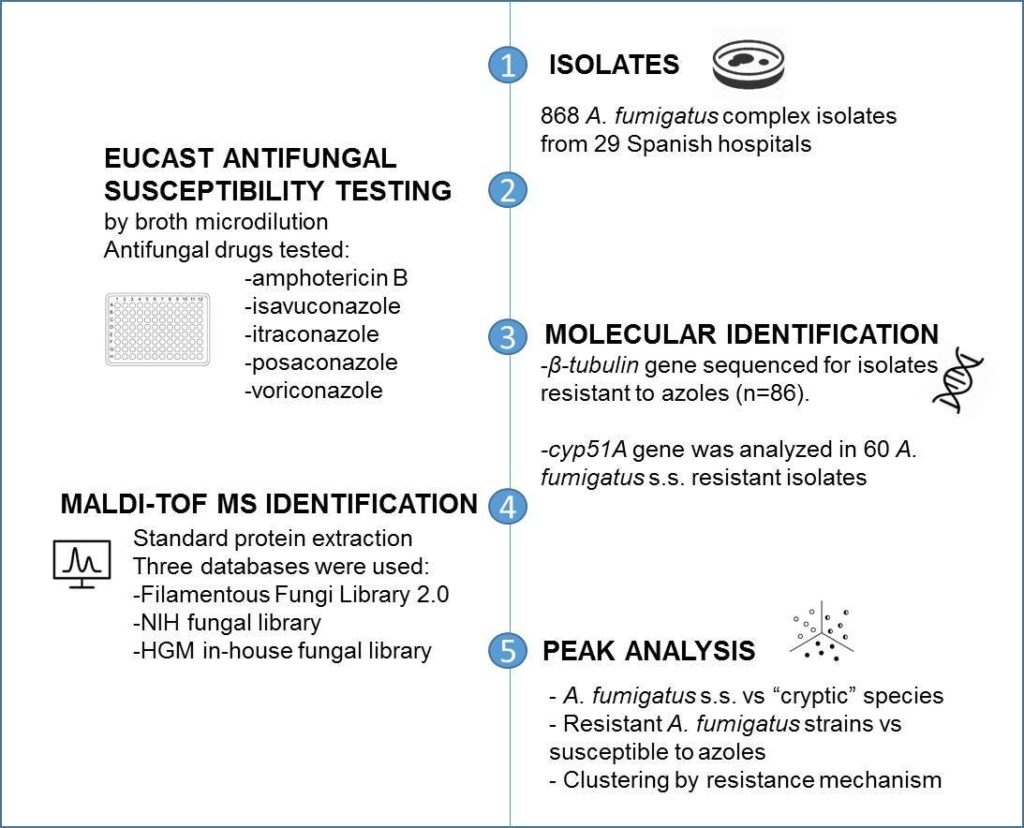Authors: Margarita Estreya Zvezdanova, Manuel J. Arroyo, Gema Méndez, Ana Candela, Luis Mancera, Julio García Rodríguez, Julia Lozano Serra, Rosa Jiménez, Inmaculada Lozano, Carmen Castro, Concepción López, Patricia Muñoz, Jesús Guinea, Pilar Escribano, and Belén Rodríguez-Sánchez on behalf of the ASPEIN group
DOI: https://doi.org/10.1016/j.cmi.2021.06.005
The Aspergillus fumigatus complex is the main etiological agent of the wide spectrum of diseases collectively known as aspergillosis, particularly affecting immunocompromised patients. Although A. fumigatus sensu stricto is clinically the most relevant species within the complex, an increasing number of sibling species showing low azole susceptibility are being described. Discrimination of A. fumigatus from the so-called cryptic species is commonly carried out using molecular procedures. This methodology has gradually become easier to implement. However, reliable phenotypic methods for accurate discrimination among A. fumigatus complex species are needed. Matrix-assisted laser desorption/ionization time-of-flight mass spectrometry (MALDI-TOF MS) has proven useful for rapid identification of different Aspergillus species. It has also been applied for antifungal susceptibility testing (AST), mostly restricted to yeasts and a limited number of filamentous fungi. Although the accuracy of this method is close to 100%, its implementation reduces the subjectivity of the method but shows no advantages in terms of turnaround time in comparison to broth microdilution methods.
The goal of this study was to apply peak analysis on MALDI-TOF MS data to i) differentiate A. fumigatus s. s. from the rest of species of the A. fumigatus complex, and ii) further detect azole resistance in A. fumigatus s. s. isolates in the absence of previous azole exposure.
Abstract:
Objectives
The main goal of this study was to accurately detect azole resistance in species of the Aspergillus fumigatus complex by MALDI-TOF MS.
Methods
Identification of isolates (n=868) was done with MALDI-TOF MS using both commercial and in-house libraries. To determine azole susceptibility, the EUCAST E.Def. 9.3.2 method was applied as the gold standard. Identification of resistant isolates was confirmed by DNA sequence analysis. Protein spectra obtained by MALDI-TOF MS were analyzed to differentiate species within the A. fumigatus complex and detect azole-resistant A. fumigatus sensu stricto isolates.
Results
Correct discrimination of A. fumigatus sensu stricto from cryptic species was accomplished in 100% of the cases applying Principal Component Analysis (PCA) to protein spectra generated by MALDI-TOF MS. Furthermore, a specific peak (4,586 m/z) was found to only be present in cryptic species. The application of Partial Least Squares Discriminant Analysis allowed 98.43% (±0.038) discrimination between susceptible and azole-resistant A. fumigatus sensu stricto isolates. Finally, based on PLS and SVM, A. fumigatus sensu stricto isolates with different cyp51A gene mutations were correctly clustered in 91.5% of the cases.
Conclusions
MALDI-TOF MS combined with peak analysis is a novel tool that allows the differentiation of A. fumigatus sensu stricto from other species within the A. fumigatus complex, as well as to detect azole-resistant A. fumigatus sensu stricto.
Although further studies are still needed, the results here reported show the great potential of MALDI-TOF and machine learning for rapid detection of azole resistant Aspergillus fumigatus isolates from clinical origin.


FULL ARTICLE:
https://www.clinicalmicrobiologyandinfection.com/article/S1198-743X(21)00322-0/fulltext
